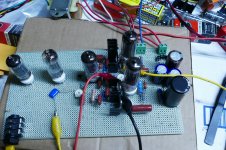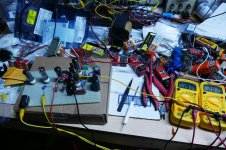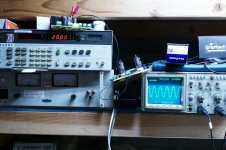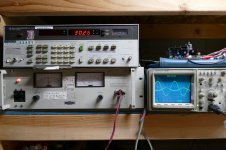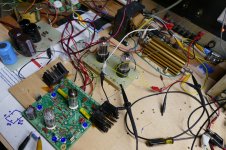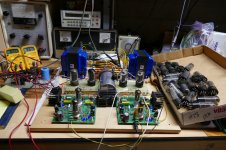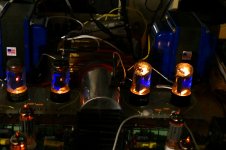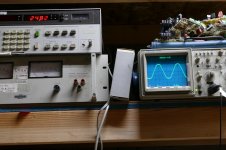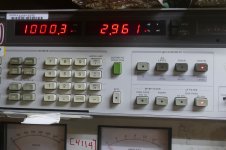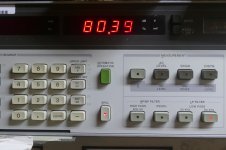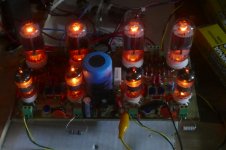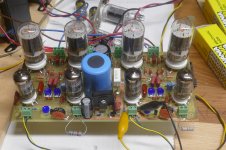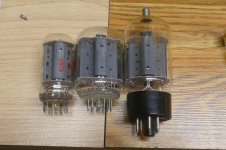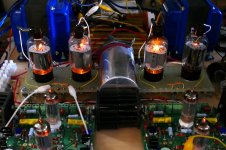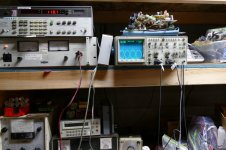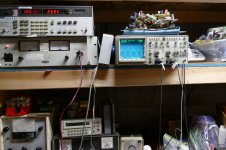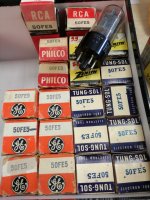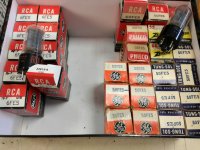I don't believe that they are (or were) the same tube when they were designed in the late 50's. The published curves and specs do not match. Both are descendants of the 6W6 / 50L6 line which became the 50C5 / 6CU5 when it was miniaturized. The evolution favored higher Gm at the expense of peak power output capability. The 6EH5 came two years later down this curve.
It is entirely possible that a tube was sold later in the vacuum tube era that carried both type numbers since each would have worked in an old radio without much difference to the average radio listener. Sylvania was the biggest offender in this regard, but in most (but not all) cases the dual or triple marked tubes had the most rugged "guts" of all the numbers it carried.
There were some 6BG6 and 807 tubes that had 7027A guts inside, and would easily run at 40 watts of dissipation, but the best example is the 6B4GA ( a DHT) with 6AV5 ( a TV sweep pentode) guts wired as a triode.
It is entirely possible that a tube was sold later in the vacuum tube era that carried both type numbers since each would have worked in an old radio without much difference to the average radio listener. Sylvania was the biggest offender in this regard, but in most (but not all) cases the dual or triple marked tubes had the most rugged "guts" of all the numbers it carried.
There were some 6BG6 and 807 tubes that had 7027A guts inside, and would easily run at 40 watts of dissipation, but the best example is the 6B4GA ( a DHT) with 6AV5 ( a TV sweep pentode) guts wired as a triode.
Tubelab_com is right ,while they dont show up in my UK equivalent books they certainly do in my AVO VCM MK4 valve (tube ) testing conditions spec.
While the initial settings are the same the test condition for the grid etc are not so interchangeability is not advised unless you change some components .
The 6CA5 has 9ma/V --while the 6EH5 has a massive 14.5ma/V,
in the same grouping as Mullard /etc Frame-Grid valves like the EF184.
807 tubes were used in the UK in military transmitting equipment in WW2 of which I have several examples , made to UK military spec they were pretty powerful and nearly "bombproof " but required the correct input impedance if used as audio tubes.
While the initial settings are the same the test condition for the grid etc are not so interchangeability is not advised unless you change some components .
The 6CA5 has 9ma/V --while the 6EH5 has a massive 14.5ma/V,
in the same grouping as Mullard /etc Frame-Grid valves like the EF184.
807 tubes were used in the UK in military transmitting equipment in WW2 of which I have several examples , made to UK military spec they were pretty powerful and nearly "bombproof " but required the correct input impedance if used as audio tubes.
The 6CA5 has 9ma/V --while the 6EH5 has a massive 14.5ma/V,
in the same grouping as Mullard /etc Frame-Grid valves like the EF184.
...but at the expense of some whopping heater power consumption of 7.56 watts!😱
One could parallel two still cheap EF184's instead to achieve about the same plate dissipation rating, gaining twice the transconductance, better plate curves, and all that with just about 3.8 watts heater power.
Best regards!
That may be so but you will notice all the large audio pentodes that are popular in output audio circuits require a large current applied to the heaters to heat up the cathodes to operating conditions of the valve design .
6L6=0.9Amps
EL34=1.5Amps
EL84=0.76Amps
807=0.9Amps
KT66=1.27Amps
KT88=1.6Amps
Apart from the 807 these are all popular tubes still being used in modern design
6L6=0.9Amps
EL34=1.5Amps
EL84=0.76Amps
807=0.9Amps
KT66=1.27Amps
KT88=1.6Amps
Apart from the 807 these are all popular tubes still being used in modern design
That's correct. But would you mind to compare the maximum output power of any of your examples with that of the 6EH5 with it's whimpy 5 watts plate dissipation limit? Not an overly attractive tube, I think.
Best regards!
Best regards!
The 6EH5 tube came out in the USA in 1940 and was designed for US tube radios a compact design at the time for military communications .
Higher plate/anode voltages in mobile communications were harder to achieve than low voltage high current for heaters.
I do agree -- inefficient.
Higher plate/anode voltages in mobile communications were harder to achieve than low voltage high current for heaters.
I do agree -- inefficient.
As stated these tubes were intended for use in radios powered directly from the AC line through a tube or selenium rectifier. The B+ varied from 110 to 130 volts. In order to get a usable watt or two, the tube must be able to pull its plate voltage down as low as possible. To do this there must be a lot of excess emission capability for a dense electron cloud. With the cathode coatings available in the 1940's, it meant a fat hot cathode. The first of it's kind was the 6Y6G which appeared in the late 1930's. The 6W6GT followed in the late 30's but did not see widespread use until after WWII.
Line powered radios needed an output tube that produced good power from a low B+, and much effort had been spent on the series string radios. The funkiest thing I ever saw was a large 50 volt tube with TWO cathodes inside, right next to each other. Sanity prevailed and a 50 volt heater was stuck inside the 6W6GT and the 50L6 was born. The specs were changed to reflect it's intended usage, but you can compare the curves, and crack open a few tubes, as I have done, and you will find these to be identical. There were other heater voltage variants for TV and both 7 and 9 pin miniature versions made from the venerable 6W6.
There was considerable work done on miniaturized vacuum tubes just before, and during WWII. The 7 pin miniature base that became popular in line powered radios first appeared in 1940.
The 7 pin miniature base was first registered to JEDEC in 1940, but I can find no evidence that the 6EH5 existed before 1958. In fact the first set of the 7 pin series string tubes did not receive JEDEC registration until late 1945. This list included the 12AU6, 12BA6, 12BE6, 35W4, and 50B5. The 50B5 is a scaled down 50L6 with a smaller plate and thus a lower dissipation rating. It's curves are still similar to the old 6W6.
The 50C5 is electrically identical to the 50B5, but the insurance underwriters of the day instituted "creepage rules" for the new PC board based radios requiring a change of pinout. The 50C5 was first seen in 1948. The 6 volt version is the 6CU5 which appeared in 1956. The 6EH5 has the new pinout, so it came after the 50C5.
The 6EH5, 50EH5 and the like diverged from the lineage of the 50C5 in the quest for higher Gm. This allowed one or more gain stages to be removed from the lineup in the quest for extreme cheapness. There were stereo phonographs with a pair of 50EH5's and a single 12AX7. This culminated in super cheap record players with nothing more than a high output ceramic cartridge, a silicon rectifier, and two 60FX5's.
The 50C5's with its wimpy 5.5 watt plate were so rated because of where and how it's used. It was the output tube in a table radio made during a time period where the average radio could see several hours of continuous play time per day, every day, for years. When these radios needed service for a weak tube, it was most often the 35W4 rectifier tube that needed changing.
These radios ran class A. Look at the "typical operation" part of the data sheet. it lists a plate voltage of 110 volts and a tube current of 50mA, that's 5.5 watts, or 100% of it's rated max.....forever. These are conservatively rated tubes. How much can they take if they were used in class AB push pull?
As stated these tubes have a 7.56 watt heater, so that plus a 5.5 watt plate and a 1.25 watt screen grid puts 14.31 watts inside the glass. Lets compare that to anther popular 7 pin output tube from the day, the 6AQ5. It wimpy 2.835 watt cathode, plus its 2 watt screen, plus its 12 watt plate puts 16.835 watts inside the same size glass. This implies that the 50C5 can eat at least 2.525 more watts on its plate. The 6AQ5 is a round plate tube. Everything inside it needs to be perfectly collinear for it to have even dissipation. Most are not, and hot spotting is a problem. Anyone who has ever beat on these tubes has seen these red spots, and the craters in the glass that they create. The 50C5's do not have these problems.
Bench testing shows that a considerable percentage of my 6AQ5's will show red spots in a dark room at 12 to 14 watts of plate dissipation. These tubes are rated for 12 watts. The 50C5's and 50B5's that I have tested can withstand 13 to 15 watts before showing red spots. Some will eat 17 watts.
Does the wimpy round cathode of the 6AQ5 VS the fat hot cathode of the 50C5 make a difference?
I ran some tests in AB2 push pull which will take best advantage of the fat hot cathode's ability to lake electrons, and thus produce a higher plate efficiency. I tried load impedance from 5000 to 10000 ohms, and adjusted plate and screen voltages independently to find best efficiency. I set an arbitrary limit of 10 watts plate dissipation for the 50C5, but used the published 12 watt spec for the 6AQ5. I respected the 1.2 watt screen dissipation spec for the 50C5, and 2 watts for the 6AQ5, but ignored all voltage specs. There are some surprises in these "wimpy" tubes!
I tried two different pairs of 6AQ5's, one set of RCA's and one set of Sylvanias. Both were selected for absence of plate glow at 14 watts of dissipation. Multiple tests were run at plate voltages from the specified 250 volts to 400 volts (way over spec), with the screen voltage adjusted for best plate efficiency without exceeding the screen grid dissipation spec. Max THD was set at 3%. Screen current usually skyrockets above 5%. Screen dissipation is the limiting factor in almost all cases except at high plate voltages. Both sets of 6AQ5's bumped into the screen or plate dissipation spec at between 10 and 12 watts of power output at all plate voltages tested. I decided to ignore the plate dissipation spec to see how far these tubes will go on 400 volts of B+ and 200 volts on the screen with a 6600 ohm load. Both pairs made 20 watts at a plate dissipation of 14 watts each. They both passed the 3% THD and 2 watt screen dissipation spec between 30 and 35 watts. The plate efficiency was a paltry 30% at the 12 watt dissipation limit, and was below 40% for ALL tests at any plate voltage or load impedance that resulted in a dissipation below 12 watts per plate. This rose to 41% at 400 volts and 14 watts per plate.
Time for some wimpy inefficient 5.5 watt tubes!
I spent quite some time twisting knobs on a pair of Sylvania 50C5's and a pair of GE 50B5's. These did best at 340 volts on the plate with a 6600 ohm load. The screen voltage was 150 and idle current was 15 mA for an idle dissipation of 5.1 watts. Of course I'm over the 5.5 watt spec before I make 1 watt...….but wait, there's more. How much more?
Remember my arbitrary 10 watt per tube plate spec......I never reached it. The 1.2 watt G2 spec is the limiting factor.
The GE 50B5's make 30 watts per pair at 1.18 watts on G2, and 8.8 watts in the plate for a plate efficiency of 63% and a THD of 2.36.
The Sylvania 50C5's make 27 watts per pair at the 3% THD limit where the G2 dissipation is 1.19 watts and the plates are eating 9.2 watts for a plate efficiency of 60%....not so wimpy.
So what happens in real life. This picture is a test board that will eventually be a 20 watt guitar amp running a pair of 50B5's (cheaper and more common than 50C5's). I have abused it with a guitar at full crank with no issues, and I set it at 20 watts into an 8 ohm load and left it running over night. The next morning it was still running making 20.02 watts.
So, if you want maximum Gm for a particular purpose, use a 6EH5. Want maximum power output, use a 6CU5. I have no actually tested a 6EH5 or a 50EH5, but other high Gm tubes have not equaled the 50C5 or its octal and 9 pin equivalents. The little 6W6 will do nearly 40 watts per pair, but that's a different story.
Line powered radios needed an output tube that produced good power from a low B+, and much effort had been spent on the series string radios. The funkiest thing I ever saw was a large 50 volt tube with TWO cathodes inside, right next to each other. Sanity prevailed and a 50 volt heater was stuck inside the 6W6GT and the 50L6 was born. The specs were changed to reflect it's intended usage, but you can compare the curves, and crack open a few tubes, as I have done, and you will find these to be identical. There were other heater voltage variants for TV and both 7 and 9 pin miniature versions made from the venerable 6W6.
There was considerable work done on miniaturized vacuum tubes just before, and during WWII. The 7 pin miniature base that became popular in line powered radios first appeared in 1940.
The 6EH5 tube came out in the USA in 1940 and was designed for US tube radio
The 7 pin miniature base was first registered to JEDEC in 1940, but I can find no evidence that the 6EH5 existed before 1958. In fact the first set of the 7 pin series string tubes did not receive JEDEC registration until late 1945. This list included the 12AU6, 12BA6, 12BE6, 35W4, and 50B5. The 50B5 is a scaled down 50L6 with a smaller plate and thus a lower dissipation rating. It's curves are still similar to the old 6W6.
The 50C5 is electrically identical to the 50B5, but the insurance underwriters of the day instituted "creepage rules" for the new PC board based radios requiring a change of pinout. The 50C5 was first seen in 1948. The 6 volt version is the 6CU5 which appeared in 1956. The 6EH5 has the new pinout, so it came after the 50C5.
would you mind to compare the maximum output power of any of your examples with that of the 6EH5 with it's whimpy 5 watts plate dissipation limit?
The 6EH5, 50EH5 and the like diverged from the lineage of the 50C5 in the quest for higher Gm. This allowed one or more gain stages to be removed from the lineup in the quest for extreme cheapness. There were stereo phonographs with a pair of 50EH5's and a single 12AX7. This culminated in super cheap record players with nothing more than a high output ceramic cartridge, a silicon rectifier, and two 60FX5's.
The 50C5's with its wimpy 5.5 watt plate were so rated because of where and how it's used. It was the output tube in a table radio made during a time period where the average radio could see several hours of continuous play time per day, every day, for years. When these radios needed service for a weak tube, it was most often the 35W4 rectifier tube that needed changing.
These radios ran class A. Look at the "typical operation" part of the data sheet. it lists a plate voltage of 110 volts and a tube current of 50mA, that's 5.5 watts, or 100% of it's rated max.....forever. These are conservatively rated tubes. How much can they take if they were used in class AB push pull?
As stated these tubes have a 7.56 watt heater, so that plus a 5.5 watt plate and a 1.25 watt screen grid puts 14.31 watts inside the glass. Lets compare that to anther popular 7 pin output tube from the day, the 6AQ5. It wimpy 2.835 watt cathode, plus its 2 watt screen, plus its 12 watt plate puts 16.835 watts inside the same size glass. This implies that the 50C5 can eat at least 2.525 more watts on its plate. The 6AQ5 is a round plate tube. Everything inside it needs to be perfectly collinear for it to have even dissipation. Most are not, and hot spotting is a problem. Anyone who has ever beat on these tubes has seen these red spots, and the craters in the glass that they create. The 50C5's do not have these problems.
Bench testing shows that a considerable percentage of my 6AQ5's will show red spots in a dark room at 12 to 14 watts of plate dissipation. These tubes are rated for 12 watts. The 50C5's and 50B5's that I have tested can withstand 13 to 15 watts before showing red spots. Some will eat 17 watts.
Does the wimpy round cathode of the 6AQ5 VS the fat hot cathode of the 50C5 make a difference?
I ran some tests in AB2 push pull which will take best advantage of the fat hot cathode's ability to lake electrons, and thus produce a higher plate efficiency. I tried load impedance from 5000 to 10000 ohms, and adjusted plate and screen voltages independently to find best efficiency. I set an arbitrary limit of 10 watts plate dissipation for the 50C5, but used the published 12 watt spec for the 6AQ5. I respected the 1.2 watt screen dissipation spec for the 50C5, and 2 watts for the 6AQ5, but ignored all voltage specs. There are some surprises in these "wimpy" tubes!
I tried two different pairs of 6AQ5's, one set of RCA's and one set of Sylvanias. Both were selected for absence of plate glow at 14 watts of dissipation. Multiple tests were run at plate voltages from the specified 250 volts to 400 volts (way over spec), with the screen voltage adjusted for best plate efficiency without exceeding the screen grid dissipation spec. Max THD was set at 3%. Screen current usually skyrockets above 5%. Screen dissipation is the limiting factor in almost all cases except at high plate voltages. Both sets of 6AQ5's bumped into the screen or plate dissipation spec at between 10 and 12 watts of power output at all plate voltages tested. I decided to ignore the plate dissipation spec to see how far these tubes will go on 400 volts of B+ and 200 volts on the screen with a 6600 ohm load. Both pairs made 20 watts at a plate dissipation of 14 watts each. They both passed the 3% THD and 2 watt screen dissipation spec between 30 and 35 watts. The plate efficiency was a paltry 30% at the 12 watt dissipation limit, and was below 40% for ALL tests at any plate voltage or load impedance that resulted in a dissipation below 12 watts per plate. This rose to 41% at 400 volts and 14 watts per plate.
I do agree -- inefficient.
Time for some wimpy inefficient 5.5 watt tubes!
I spent quite some time twisting knobs on a pair of Sylvania 50C5's and a pair of GE 50B5's. These did best at 340 volts on the plate with a 6600 ohm load. The screen voltage was 150 and idle current was 15 mA for an idle dissipation of 5.1 watts. Of course I'm over the 5.5 watt spec before I make 1 watt...….but wait, there's more. How much more?
Remember my arbitrary 10 watt per tube plate spec......I never reached it. The 1.2 watt G2 spec is the limiting factor.
The GE 50B5's make 30 watts per pair at 1.18 watts on G2, and 8.8 watts in the plate for a plate efficiency of 63% and a THD of 2.36.
The Sylvania 50C5's make 27 watts per pair at the 3% THD limit where the G2 dissipation is 1.19 watts and the plates are eating 9.2 watts for a plate efficiency of 60%....not so wimpy.
So what happens in real life. This picture is a test board that will eventually be a 20 watt guitar amp running a pair of 50B5's (cheaper and more common than 50C5's). I have abused it with a guitar at full crank with no issues, and I set it at 20 watts into an 8 ohm load and left it running over night. The next morning it was still running making 20.02 watts.
So, if you want maximum Gm for a particular purpose, use a 6EH5. Want maximum power output, use a 6CU5. I have no actually tested a 6EH5 or a 50EH5, but other high Gm tubes have not equaled the 50C5 or its octal and 9 pin equivalents. The little 6W6 will do nearly 40 watts per pair, but that's a different story.
Attachments
7695 has a voltage and heating current equal to 50B5 or 50C5, but the allowed anode dissipation is even Pa = 16W (Pg2 = 2.5W)! How much power could the 7695 pair give, if a weak 50B5 pair (Pa = 5.5W and Pg2 = 1.25W) can give as much as 20W of power output?
I certainly repaired a large number of American miniature bakelite radios and the line cords supplied .
UK citizens didn't realize a line cord existed and cut down the cord resulting in blown heaters , I also remember the 50V heater pentodes in those radios had to shoehorn them in.
Overheating was always a problem cracking the bakelite case they were the first mod I tried with a series capacitor in place of the line cord and yes it worked .
UK citizens didn't realize a line cord existed and cut down the cord resulting in blown heaters , I also remember the 50V heater pentodes in those radios had to shoehorn them in.
Overheating was always a problem cracking the bakelite case they were the first mod I tried with a series capacitor in place of the line cord and yes it worked .
With the overpowering tests you made on old 50B5 / 50C5's running so far over spec successfully, 30W is amazing!, did you ever run such tests with the 50L6 tubes? I suspect they would be equally impressive and I have quite a few of them. I would love to see what is possible. I have some 25L6GT large tubes that might be just perfect for something like this.
did you ever run such tests with the 50L6 tubes?
Here are some pictures of a pair of 25L6GT's cranking out 30 watts at a rather benign 300 volts of B+ into a 3300 ohm load. I later figured out that I got more power with more voltage and a higher load impedance.
I also wired two pair of 6W6GT's up in triode mode and squeezed 25 watts per channel out of them. The red glowing spot in the middle of the leftmost tube in the dark picture is an artifact of the camera since it is looking through the little window in the plate directly at the cathode. The plate is not glowing.
The 6W6GT, 12L6, 12W6, 25L6, 25W6, 50L6 and 6DG6GT are all the same tube except for the heater voltage. The 35L6 is a different tube with a wimpy cathode and the 6L6 is a bigger audio tube.
The 6GC5 is a 6W6 in a fat 9 pin bottle, and the 6DB5 is a 6W6 with a cut down plate to fit inside a normal 9 pin bottle. The 6DB5 can not handle as much plate power as the 6W6 due to it's smaller size.
The 6CU5, 12C5, 17C5, 25C5, and 50C5 all have identical guts except for the heater ratings, the 50B5 is identical except for the pinout. All are derived from the 6W6 with slightly smaller internals to fit inside the plate structure, which itself is smaller to fit inside the 7 pin bottle.
How much power could the 7695 pair give
The 7695 and it's 6.3 volt brother the 7754 are unique as far as I know. I have seen a few over the years but they are not common so I have never tested them. They have a higher Gm than most of these other tubes, but I have no real information on what they can do since I only have one at the moment.
UK citizens didn't realize a line cord existed and cut down the cord resulting in blown heaters
There were a few radios sold in the US in the late 40's that had a third nichrome wire in the power cord that was the dropping resistor for the heater string. I might have learned about this the hard way myself when I was a dumb kid fixing scrap radios or making guitar amps out of them.
Attachments
I tested a 7754 (7695) tube on the curve tracer a year or two back and it was nearly identical to a 12GE5/12JN6. The datasheet for the 7754 (7695) is just spec'd at a higher current to get the high gm. A 6GF5 would likely be very close, and are available at $1. The 12GE5/12JN6 are rated 17 Watts and 550 mA peak current.
The 7695-noval is a 50FE5-octal successor with 50V / 0.15A heating (such as the 7695-noval, 6FE5-octal successor with 6.3V / 1.2A heating) with almost identical published manufacturer data. With 50FE5 tubes I have positive experiences in working with low voltage amplifiers, so although I have a smaller stock of 7695 tubes, it is a very useful fact (thanks to the smoking-amp) that they are very similar to 12GE5 / 12JN6 (6JN5 / 6JN6).
The 7695-noval is a 50FE5-octal successor with 50V / 0.15A heating
I have never seen a 6FE5 or a 50FE5. I have the data sheet, so I must have found a reason to look for it at some point. They don't seem too common here.
A 6GF5 would likely be very close
Now that's a tube I have explored for almost 60 years.
The 6GE5 IS a 6DQ6 in a 12 pin Compactron bottle. The 6GF5 is a 6GE5 with it's plate fins trimmed so that it will fit in a skinny Compactron bottle. All three seen together here. I have found three different constructions of 6GF5 all with a different height. All can make big power, 80 WPC. Real big for a "9 watt" tube. The fat boy 6DQ6 and 6GE5's can make 100 to 110 WPC in a convertional circuit like Pete Milletts Engineers amp. The last 3 pictures show a set of 17DQ6's pushing the meter to 110 watts at 2.5% THD.
As a kid with very limited knowledge I wired up guitar amps with old TV parts. I could make a screaming guitar amp with the 6BQ6GT's often found in dead B&W TV sets. I never understood why the amp was not as loud and the tube red plated when I stuck in the bigger 6DQ6...of course understanding things like bias, impedance, and load lines didn't come until high school electronics classes.
Fast forward to 2018 and we have 4 X 6GF5's and 4 X 6KT6 ($8 worth of tubes) cranking out 80 WPC at 3% THD.
The output stage used here is a unique design that I'm working on. It will be tested with some monster sweep tubes soon for BIGGER power. The phase inverter seen in this amp uses a similar design, but I'm not happy with it. I made a better design for the 50C5 guitar amp, and it is being scaled up for a bigger version.
Attachments
I am quite surprised that you, as a very experienced electronics engineer who live and work in the USA where 6FE5 and 50FE5 were constructed, have never seen them !?I have never seen a 6FE5 or a 50FE5. I have the data sheet, so I must have found a reason to look for it at some point. They don't seem too common here.
...
Attachments
- Home
- Amplifiers
- Tubes / Valves
- Is the 6CA5/6eh5 the Same?
